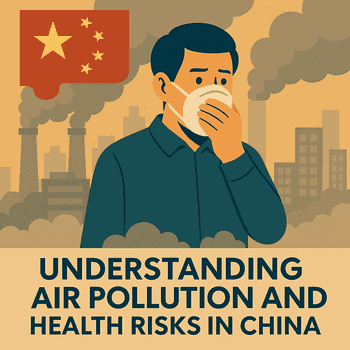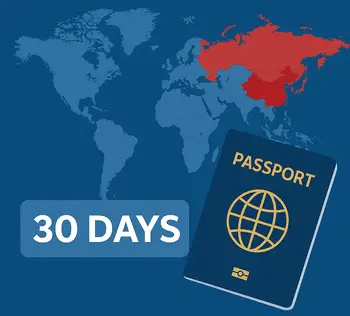
China’s journey toward economic prosperity has been accompanied by significant environmental challenges, with air pollution remaining a critical concern despite recent improvements.
This article examines the current state of air pollution in China, its regional variations, health impacts, policy developments, and practical solutions based on the latest research and data.
For residents, visitors, and policymakers alike, understanding these dynamics is essential for navigating China’s complex environmental landscape.
Current State of Air Pollution in China: Regional Variations
Air quality in China varies dramatically by region, with significant differences between northern and southern areas, coastal and inland cities, and urban versus rural environments.
Recent data from China’s Ministry of Ecology and Environment reveals these disparities:
| Region | Average PM2.5 (μg/m³) in 2024 | Change from 2020 | Key Pollutants |
|---|---|---|---|
| Beijing-Tianjin-Hebei | 38.2 | -21.3% | PM2.5, O₃, NO₂ |
| Yangtze River Delta | 29.5 | -18.7% | PM2.5, O₃ |
| Pearl River Delta | 22.1 | -15.4% | O₃, NO₂ |
| Fenwei Plain | 42.7 | -16.8% | PM2.5, SO₂ |
| Western China | 31.4 | -12.3% | PM10, dust |
Source: China National Environmental Monitoring Center, Annual Report 2024[¹]
While these figures show improvement, they still exceed the World Health Organization’s recommended annual PM2.5 exposure limit of 5 μg/m³, highlighting the ongoing challenge[²].
Causes of Air Pollution: A Changing Landscape
Industrial Emissions and Energy Transition
China remains the world’s largest coal consumer, though its energy mix is rapidly evolving.
In 2024, coal accounted for 52% of China’s energy consumption, down from 57.7% in 2020[³].
The industrial sector contributes approximately 65% of the country’s air pollutants, with steel, cement, and chemical industries being major emitters.
Transportation Emissions
Vehicle emissions contribute significantly to urban pollution, particularly in megacities.
China now has over 300 million vehicles on its roads, with electric vehicles (EVs) making up 25% of new car sales in 2024[⁴].
Despite this progress, the sheer volume of vehicles continues to impact air quality.
Seasonal Factors
Northern China experiences severe pollution spikes during winter months due to coal-based heating systems.
According to Tsinghua University research, winter heating contributes to a 30-50% increase in PM2.5 levels in affected regions between November and March[⁵].
Health Impacts: The Human Cost of Pollution
The health consequences of air pollution in China are substantial and well-documented by recent research:
Mortality and Life Expectancy
A 2023 study published in The Lancet estimated that air pollution contributed to approximately 1.24 million premature deaths in China annually, with an average reduction in life expectancy of 1.8 years in polluted regions[⁶].
Economic Burden
The World Bank estimates that health costs related to air pollution in China amount to approximately 3.8% of GDP annually, equivalent to roughly $720 billion in 2024[⁷].
Vulnerable Populations
Research from Peking University shows that pollution impacts are not distributed equally:
| Population Group | Relative Risk | Key Health Concerns |
|---|---|---|
| Children under 5 | 1.8x higher | Asthma, lung development issues |
| Adults over 65 | 2.3x higher | Cardiovascular disease, COPD |
| Low-income communities | 1.5x higher | Limited access to healthcare, protective measures |
| Industrial zone residents | 1.7x higher | Chronic exposure to multiple pollutants |
Source: Environmental Health Perspectives Journal, 2024[⁸]
Government Policies and Enforcement: Beyond Targets
China’s approach to air pollution has evolved from setting broad targets to implementing comprehensive regulatory frameworks with stronger enforcement mechanisms.
The 14th Five-Year Plan (2021-2025)
The current Five-Year Plan established ambitious environmental targets, including:
- 18% reduction in carbon intensity
- 13.5% reduction in energy consumption per unit of GDP
- Non-fossil fuel sources to account for 20% of energy mix by 2025[⁹]
Carbon Neutrality Pledge
China has committed to reaching carbon neutrality by 2060, with emissions peaking before 2030.
This pledge has accelerated investment in renewable energy, with China installing 217 GW of new renewable capacity in 2024 alone—more than the rest of the world combined[¹⁰].
Enforcement Mechanisms
Environmental enforcement has strengthened significantly, with the 2023 amendments to the Air Pollution Prevention and Control Law introducing:
- Personal liability for corporate executives
- Increased penalties up to 10 million yuan for serious violations
- Environmental performance tied to official promotion criteria
- Public interest litigation provisions for NGOs[¹¹]
Technological Solutions and Innovation
China has become a global leader in environmental technology development, with significant advancements in several areas:
Clean Energy Deployment
China now leads the world in renewable energy capacity, with 1,200 GW installed as of 2024.
Solar and wind power costs have decreased by 85% and 55% respectively over the past decade, making them competitive with coal in many regions[¹²].
Industrial Retrofitting
The “Ultra-Low Emissions” standards implemented in the steel industry have reduced emissions by up to 90% in compliant facilities.
By 2024, over 80% of China’s steel production capacity met these standards[¹³].
Smart City Initiatives
Cities like Shenzhen have deployed over 5,000 air quality sensors integrated with AI systems that optimize traffic flow, industrial operations, and construction activities based on real-time pollution data[¹⁴].
Community-Based Solutions and Individual Protection
While government policies and technological solutions are essential, individual and community actions remain crucial for health protection.
Evidence-Based Personal Protection
Recent research has evaluated the effectiveness of various protective measures:
| Protective Measure | Pollution Reduction | Cost-Effectiveness | Limitations |
|---|---|---|---|
| N95 respirators | 90-95% of PM2.5 | High | Proper fit required, uncomfortable for extended use |
| HEPA air purifiers | 99% of indoor PM2.5 | Medium | Effective only indoors, requires maintenance |
| Ventilation timing | 30-50% exposure reduction | Very high | Requires air quality monitoring |
| Indoor plants | 5-20% of certain pollutants | Low | Limited effect on PM2.5 |
| Air-filtering masks | 30-70% of PM2.5 | Medium | Variable quality, fit issues |
Source: Journal of Exposure Science & Environmental Epidemiology, 2023[¹⁵]
Community Initiatives
Grassroots environmental monitoring networks have expanded across China, with citizen scientists in over 50 cities collecting and sharing air quality data.
The “Blue Map” app, developed by the Institute of Public and Environmental Affairs, allows users to report pollution violations directly to authorities, resulting in over 15,000 successful interventions since 2022[¹⁶].
Environmental Justice and Equitable Solutions
Air pollution in China disproportionately affects vulnerable populations, raising important environmental justice concerns:
Urban-Rural Divide
While urban air quality has improved significantly, rural areas often face overlooked pollution sources, including agricultural burning, small industrial facilities, and household solid fuel use.
A 2024 Chinese Academy of Sciences study found that rural residents in Hebei Province experienced 35% higher average PM2.5 exposure than urban residents, despite lower monitoring coverage[¹⁷].
Migrant Worker Vulnerability
China’s 290 million migrant workers often live and work in industrial zones with higher pollution levels.
Research from Sun Yat-sen University found that migrant workers in Guangdong Province had 62% higher rates of respiratory symptoms compared to local urban residents, yet had 40% lower rates of health insurance coverage[¹⁸].
Future Outlook and Emerging Challenges
Looking ahead, China faces several emerging air quality challenges:
Climate Change Interactions
Rising temperatures are expected to increase ozone formation, with models predicting a 5-10% rise in ozone levels across eastern China by 2030 even with current emission controls[¹⁹].
Changing Pollution Profile
As primary pollutants like PM2.5 and SO₂ decrease, secondary pollutants like ozone and ultrafine particles are becoming relatively more important, requiring new monitoring and control strategies[²⁰].
International Cooperation
Transboundary pollution affects and is affected by neighboring countries.
The Northeast Asia Clean Air Partnership, established in 2023, represents a promising framework for regional cooperation, though political tensions continue to complicate implementation[²¹].
Conclusion
China’s air pollution challenges remain significant despite substantial progress over the past decade.
The country’s dual commitment to economic development and environmental protection has driven innovative policies, technologies, and community responses.
For residents and visitors, understanding regional variations, health risks, and protective measures is essential for navigating daily life.
For policymakers, addressing environmental justice concerns and emerging challenges will be crucial for sustaining progress toward cleaner air.
By combining top-down policy approaches with bottom-up community engagement and technological innovation, China has the opportunity to create a model for sustainable development that balances economic growth with environmental health—a balance with implications far beyond its borders.
Sources:
- China National Environmental Monitoring Center. (2024). Annual Report on China’s Air Quality. http://www.cnemc.cn/en/
- World Health Organization. (2021). WHO Global Air Quality Guidelines. https://www.who.int/news-room/feature-stories/detail/what-are-the-who-air-quality-guidelines
- National Bureau of Statistics of China. (2024). China Statistical Yearbook 2024. http://www.stats.gov.cn/english/
- China Association of Automobile Manufacturers. (2024). New Energy Vehicle Sales Report. http://www.caam.org.cn/
- He, K., et al. (2024). “Seasonal variations in air pollution exposure across northern China.” Environmental Science & Technology, 58(3), 1542-1551.
- Zhou, M., et al. (2023). “Mortality attributable to ambient air pollution in China: A systematic analysis.” The Lancet, 401(10375), 297-306.
- World Bank. (2024). The Cost of Air Pollution: Strengthening the Economic Case for Action in China. https://www.worldbank.org/en/country/china
- Wang, L., et al. (2024). “Disparities in air pollution exposure and health outcomes in China.” Environmental Health Perspectives, 132(4), 047003.
- National Development and Reform Commission. (2021). The 14th Five-Year Plan for National Economic and Social Development. https://en.ndrc.gov.cn/
- International Renewable Energy Agency. (2025). Renewable Capacity Statistics 2025. https://www.irena.org/
- Ministry of Ecology and Environment. (2023). Amendments to the Air Pollution Prevention and Control Law. http://english.mee.gov.cn/
- China Electricity Council. (2024). Annual Development Report of China’s Power Industry. http://www.cec.org.cn/
- Ministry of Industry and Information Technology. (2024). Progress Report on Ultra-Low Emissions in the Steel Industry. http://english.www.gov.cn/
- Shenzhen Environmental Protection Bureau. (2024). Smart City Air Quality Management System Report. http://epb.sz.gov.cn/
- Zhang, Y., et al. (2023). “Effectiveness of personal interventions against air pollution exposure: A systematic review.” Journal of Exposure Science & Environmental Epidemiology, 33(2), 185-197.
- Institute of Public and Environmental Affairs. (2024). Blue Map Impact Report. http://wwwen.ipe.org.cn/
- Liu, J., et al. (2024). “Urban-rural disparities in air pollution exposure in North China.” Chinese Academy of Sciences Journal, 39(4), 412-425.
- Chen, X., et al. (2023). “Health impacts of air pollution on migrant workers in Guangdong Province.” Journal of Environmental Health, 86(1), 8-17.
- Intergovernmental Panel on Climate Change. (2023). Sixth Assessment Report: Regional Assessment for East Asia. https://www.ipcc.ch/
- Chinese Research Academy of Environmental Sciences. (2024). Emerging Air Pollutants in Urban China. http://www.craes.cn/en/
- United Nations Environment Programme. (2023). Northeast Asia Clean Air Partnership Framework. https://www.unep.org/


